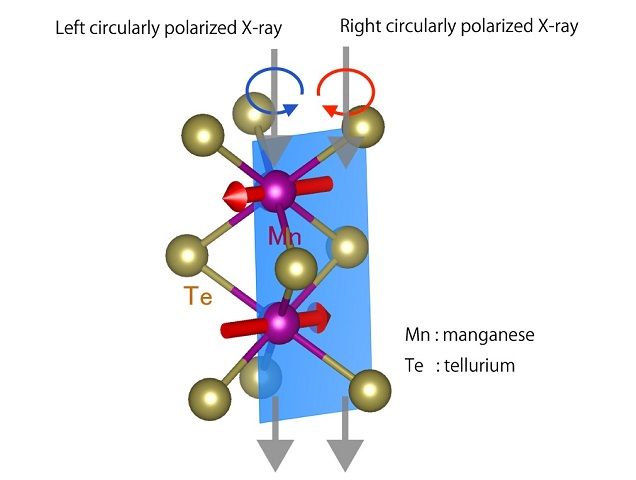Research News
Jun 14, 2024
- Engineering
New approach to identifying altermagnetic materials
Theoretical simulations and synchrotron experiments reveal the hidden fingerprint of new magnets
Radiating altermagnetic alpha-manganese telluride with X-rays
Using X-ray magnetic circular dichroism, an Osaka Metropolitan University-led international research team found the spectrum characteristic of α-MnTe.
Credit: Osaka Metropolitan University

Magnetic materials have traditionally been classified as either ferromagnetic, like the decorative magnets on iron refrigerator doors that are seemingly always magnetic, or antiferromagnetic, like two bar magnets placed end-to-end with opposite poles facing each other, canceling each other out so that the material has no net magnetism. However, there appears to be a third class of magnetic materials exhibiting what in 2022 was dubbed altermagnetism.
Microscopically, magnetism arises from a collection of tiny magnets associated with electrons, called spin. In ferromagnetic materials, all the electron spins point in the same direction, while in antiferromagnetic materials, the electron spins are aligned in opposite directions, half pointing one way and half the other, canceling out the net magnetism. Altermagnetic materials are proposed in theory to possess properties combining those of both antiferromagnetic and ferromagnetic materials. One potential application of altermagnetic materials is in spintronics technology, which aims to utilize the spin of electrons effectively in electronic devices such as next-generation magnetic memories. However, identifying altermagnets has been a challenge.
An international research group led by Associate Professor Atsushi Hariki from the Graduate School of Engineering at Osaka Metropolitan University pioneered a new method to identify altermagnets, using manganese telluride (α-MnTe) as a testbed.
With the aid of a supercomputer, the researchers theoretically predicted a fingerprint of altermagnetism in X-ray magnetic circular dichroism (XMCD), which measures the absorption difference between left- and right-circularly polarized light. Then, using the Diamond Light Source synchrotron in England, they experimentally demonstrated the XMCD spectrum for altermagnetic α-MnTe for the first time in the world.
“Our results show that XMCD is an effective method for the simple identification of altermagnetic materials,” Professor Hariki said. “Also, it can be expected to further accelerate the application of altermagnets in spintronics.”
The findings were published in Physical Review Letters.
Funding
This work was supported in part by JSPS KAKENHI Grant Numbers 21K13884, 21H01003, 23K03324, 23H03816, and 23H03817, and the 2023 Osaka Metropolitan University (OMU) Strategic Research Promotion Project for Younger Researchers.
Paper information
Journal: Physical Review Letters
Title: X-ray Magnetic Circular Dichroism in Altermagnetic α-MnTe
DOI: 10.1103/PhysRevLett.132.176701
Authors: A. Hariki, A. Dal Din, O. J. Amin, T. Yamaguchi, A. Badura, D. Kriegner, K. W. Edmonds, R. P. Campion, P. Wadley, D. Backes, L. S. I. Veiga, S. S. Dhesi, G. Springholz, L. Smejkal, K. Vyborny, T. Jungwirth, and J. Kunes
Published: 23 April 2024
URL: https://doi.org/10.1103/PhysRevLett.132.176701
Contact
Graduate School of Engineering
Email: hariki[at]omu.ac.jp
*Please change [at] to @.
SDGs
